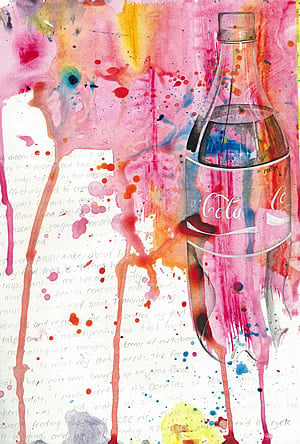Last Updated on September 1, 2023
Many high school Art students (such as those studying AS or A2 Level Art & Design) must present a Coursework or Exam portfolio that shows development. Students are sometimes confused about what the term ‘development’ means in this context, and are uncertain about how they should go about achieving this. This article endeavours to answer these questions and provides a process by which students can ensure their work develops sufficiently. This is intended as a broad guide only, and should be used only in conjunction with advice from your teacher.
If you are told that your work must show development, your teacher is telling you that your work must change a little (both in use of media and composition) from one piece to the next. In other words, an A Level Art Coursework portfolio must tell a visual story: with a starting point, a conclusion, and a journey in between. It is not acceptable, for example, to show the same things drawn or painted from different angles over and over again, or to execute the same composition first in pastel, then in paint, then in charcoal and so on…or to submit paintings of many different items that have no visual or thematic connection to each other.
‘Development’ means systematically working towards better artwork: trialing, refining and exploring compositional devices and technique, demonstrating to the examiners that you have gone through a learning process and arrived at a successful final piece.
As an example, the following process was undertaken by my A Level Painting students (this process could be easily modified for Graphic Design, Photography or Sculpture) during the course of the year:

1. Select an original, personally relevant, visually complex, readily-available A Level subject or theme that can sustain your interest for a year (see the accompanying guide: how to select a good A Level Art theme);
2. Complete 4-10 drawings of your chosen topic in your A Level Art Sketchbook, using a range of black and white and coloured mediums such as graphite pencil, Indian ink, acrylic, coloured pencil, watercolours, oil. The level of realism achieved in these drawings will be dependent on your own drawing style and preferences. Mix and layer mediums as appropriate. Include photographs if desired. The drawings may be semi-incomplete and can merge into each other. At this point, do not worry so much about what you are achieving in terms of composition. You are merely conducting visual research and exploring your topic.
3. Fill gaps around the drawings with notes discussing your theme / issue / message…why this is personally relevant to you; what appeals to you visually about the subject; how the subject matter might be composed in order to support or convey your ideas. Look carefully at what you have drawn and make notes about how the visual elements (line, tone, texture, space, colour etc) interact… For example, are there strong contrasts between highly detailed areas and sparse areas? Are the negative spaces as interesting as the objects themselves? Are there repetitions of certain shapes and colours? Are you exploring frames within frames? …In essence, establish what you are dealing with visually.

4. Select an artist model whose work relates to your subject matter and inspires you. Research this artist. Complete several pages in your A Level Art Sketchbook, including composition studies, imitations and pastiches of their artwork, using a range of mediums. Fill spaces around the illustrations with notes explaining/discussing their technique/s (mark-making methods); use of media / materials; style; composition (i.e. the relationship between the visual elements: line, shape, colour, tone, texture and space. Discuss how these elements form ‘visual devices’ that ‘draw attention’, ‘emphasise’, ‘balance’, ‘link’ or ‘direct the viewer through the artwork’ and so on). Write notes about the ideas, moods and subjects explored within the drawings and how all of the above relates to your topic or theme. Your comments should show evidence that you have researched your artist (using proper terminology) and should also contain your own thoughts and responses. Under no circumstances should it appear as if you are just regurgitating information from a textbook. Learn from this artist and establish how this artist is relevant / useful for your own project.
5. Complete 10 – 15 drawings and paintings that show a smooth transition from your original artworks to images that are influenced by your first artist model.
Do not leap in and copy everything the artist does. It may be, for example, that you simply copy the way a particular artist uses foreground, mid-ground and background, or the way in which they apply paint onto a scratched, irregular surface. The purpose of this exercise is to learn particular techniques or compositional strategies – not to copy their work in its entirety. The result should be a series of paintings which show gradual changes and exploration. After each one you should have a discussion with your teacher about what you can do next to help convey your ideas more successfully.
6. When you have learned all that you need to from the first artist, select another artist and repeat the process. Once you have learned from this artist, repeat again. The intention is that by the time you get to your final piece, your work is a beautiful combination of your own ideas and the influence of several others. Your work should look absolutely original – a beautiful mixture of wisdom gained from a multitude of sources. It can be good practice to choose a range of artist models – ie. national / international, contemporary / historical etc…but this is not always necessary. The best outcomes occur when students choose artists whose work really moves them. It can be typical for an AS student to have 2-4 artist models and A2 students to have 3-10 artist models.
Here is a well-developed A Level (A2) Painting portfolio by Nikau Hindin, a talented A Level Art student from ACG Parnell College. Her A2 Coursework portfolio achieved 98%.

Still unsure? Viewing our Featured Art Projects will also help you understand how to develop your ideas within your work.

